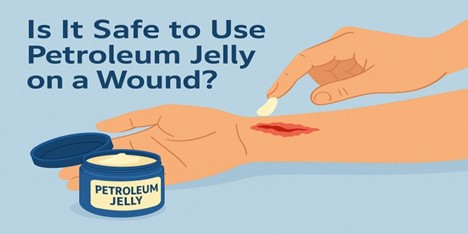Petroleum jelly, commonly known by its brand name Vaseline, is one of the most widely used substances in skincare. But a common question people often ask is:
Is it safe to apply petroleum jelly to a wound?
The short answer is: Yes, applying petroleum jelly to minor, clean wounds is generally safe and even beneficial—as long as the wound is not infected and proper hygiene is maintained.

Why Is Petroleum Jelly Recommended for Wounds?
Petroleum jelly forms a protective barrier over the skin, which helps retain moisture and prevents the wound from drying out. This moist environment supports the skin’s natural healing process and reduces the likelihood of scarring.
In fact, many healthcare professionals recommend using petroleum jelly after small surgical procedures or minor cuts. It keeps the wound soft, reduces itchiness, and shields it from outside contaminants.
However, it’s crucial to emphasize that petroleum jelly should only be applied to clean, disinfected wounds. If there’s any sign of infection or pus, sealing the wound with any occlusive material—including petroleum jelly—might trap bacteria and worsen the condition.
How Does It Compare to Waxes and Mineral Oil?
Some people wonder if other moisturizing substances like waxes or mineral oil can serve the same purpose. While waxes—such as beeswax or paraffin—are used in cosmetic and protective products, their hydration-retention properties don’t last as long as petroleum jelly. Moreover, waxes may not be ideal for use on fresh or sensitive wounds due to their heavier, more solid texture.
On the other hand, mineral oil is a lighter substance that is often used as a base in lotions and moisturizers. It helps hydrate the skin but lacks the sealing effect that petroleum jelly provides. While mineral oil is suitable for dry skin or general skincare, it’s not typically used directly on wounds for healing.
What Is Petroleum Jelly Used For?
The most common uses of Vaseline are to protect and heal minor wounds, moisturize dry skin, and soothe chapped lips. It is also useful for treating minor burns, preventing diaper rash, and softening cuticles. In everyday use, it reduces skin friction, removes eye makeup, and protects skin from harsh weather. Beyond personal care, Vaseline has a role in light industrial applications, similar to how waxes and cable gels are used to seal and protect.
When Should You Avoid Petroleum Jelly?
Although petroleum jelly is safe in most cases, you should avoid using it under the following conditions:
- If the wound is deep, infected, or discharging pus
- On second- or third-degree burns
- If you have known sensitivity or allergies to petroleum-based products
In such situations, it’s best to consult a healthcare professional or use antibiotic ointments as directed.
Conclusion
Petroleum jelly remains one of the most reliable and accessible options for treating minor wounds. When used properly, it can speed up healing and reduce scarring. While waxes and mineral oil have their own places in skincare and cosmetic formulations, neither provides the same wound-sealing and protective properties as petroleum jelly.
Always make sure the product you’re using matches the intended application—and when in doubt, consult a professional.
Comments on “Is It Safe to Use Petroleum Jelly on a Wound?”